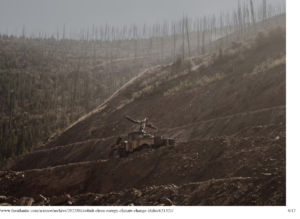A Rare Earth Mine in the Bitterroot
Is it worth the risk?
Sheep Creek Mine update:
In October 2022 US Critical Materials Corp https://uscriticalmaterials.com/ added 169 new claims to a block of old claims for a combined total of 4,500 acres in a new project aimed at mining rare earth elements (REEs) at the head of the Bitterroot River. Since then USCM has explored their claims with detailed geological and geophysical mapping, opening a few old adits (underground tunnels), as well as assay sampling of rock, soil and stream sediment. Because these activities are not considered “ground disturbance” by permitting agencies (BNF and MTDEQ) the Company was allowed to proceed with simple Notice of Intent (NOI) permits that do not entail assessments of environmental damage or any public involvement process.
The Company has documented some very high REE assay results and has produced many press releases hyping the project, sometimes with misinformation like, “The US Critical Materials deposit in Montana has sufficient rare earths and gallium to provide the world with the critical elements it needs to help meet demand well into the future”. In fact they do not know if there is “sufficient” high grade ore on their property beyond what can be seen on surface and in the relatively small adits, which is clearly not sufficient. Drilling will be necessary to determine the volume of ore. The Company has created much mistrust with misleading statements and hyperbolic sales pitches.
Also creating mistrust, the company has announced immanent exploration drilling a couple times over the years only to fail to even submit plans to the BNF and Montana DEQ for the necessary exploration permits. This is good news, but to stay viable and ground truth their hype much longer they will need to drill. They recently told a reporter they expect to file a Plan of Operation (PoO) with the US Forest Service in the second quarter of 2025 . We can’t assume their statement is just more bunk, so we continue to prepare.
After the Company submits their exploration plan to the BNF and MTDEQ, those agencies will initiate a public process asking the public for “scoping issues”, i.e. what we, the public, would like to see in the way of analysis and mitigation of environmental threats preceding signing of exploration permits. It is very important that members of the public submit comments to demonstrate large scale opposition to the proposed Sheep Creek Mine.
The time allowed for public comment could be very short due to recent adoption of expedited permitting processes. Due to the possibility of a very short comment period some citizen groups have consolidated issues ahead of the official period and will refine that “Pre-scoping” document once specific plans in the PoO are revealed to the public. Our updated scoping comment document will be made available for public use. See current pre-scoping comments: https://www.friendsofthebitterroot.net/pdf-sheep-creek-pre-scoping/
One critical issue we have highlighted is the question about presence, or not, of asbestos in the rock at the mine site. This potentially deadly issue needs to be addressed before any “ground disturbing” activities take place. Permitting agencies should require USCM to pay for an independent analysis. It is well documented that a significant amount of the mineral actinolite is intimately associated with the minerals USCM would be targeting. Actinolite can be asbestiform in a class known as amphibole asbestos, which is even more toxic than the more usual type of asbestos. In 1960 it was first reported that Sheep creek actinolite “forms masses of radiating fibers surrounding other crystals”. Tremolite, closely related to actinolite, has killed hundreds of people in and around Libby is an amphibole asbestos. Dust containing amphibole asbestos can travel far and wide and is very difficult to ever clean up. Prevention is the only solution. Drilling exploration is dusty business. See: https://missoulacurrent.com/viewpoint-mine-asbestos/
What you can do now
If you haven’t already, you may want to email West Fork Ranger Dan Pliley Daniel.pliley@usda.gov and ask to be put on the list of concerned citizens to be alerted when the Sheep Creek Exploration PoO is released, starting the public scoping comment period. You might want to offer some pre-scoping comments in your email. Finally, be ready to write comments when the PoO is released to the public and the official public comment period opens.
Article in Field and Stream on Sheep Creek
"Ramsey says there’s a high probability that it will include a large open-pit mine. “Every profitable rare-earth element mine is an open-pit mine, and they’ve all had radioactive leaks,” he says."
Damaging exploration drilling DELAYED. Thanks to you.
Sheep Creek drilling delayed because US Critical Materials found the project to be "high profile." That is thanks to you for writing to Ranger Pliley and signing the petition.
Sign the petition against exploration drilling and mining activities in Sheep Creek
Be Ready!
US Critical Materials posted an article on their website saying they would be drilling this coming summer of 2024. When we asked the Forest Service,, they knew nothing about it. But after our conversation with the West Fork Ranger, the article was taken down. But we got a screenshot before they took it down. We expect a Plan of Operation for exploration drilling in April. We will keep you updated. Make sure you are on our mailing list.
Here is their destructive "exploration" plan:
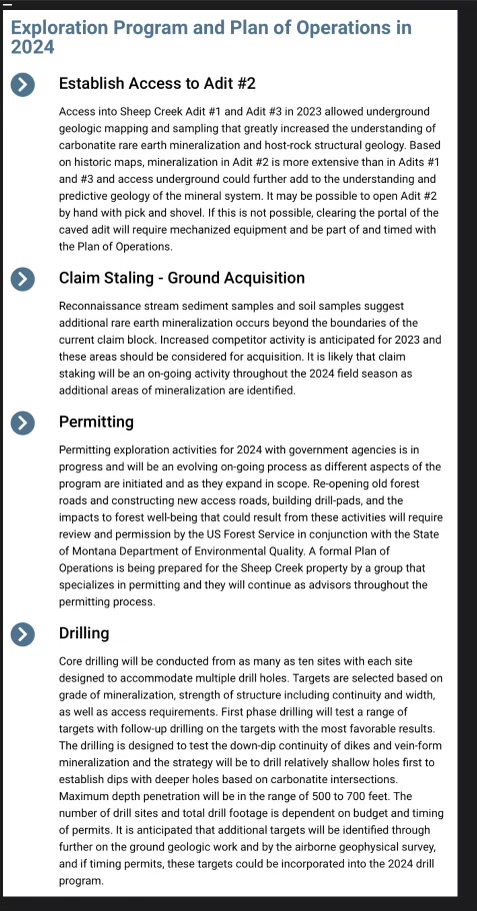
Friends of the Bitterroot and 18 other groups send a letter
to the Forest Service concerning the Sheep Creek mine.
They are asking for robust analysis, transparency, and public involvement, citing a long overdue Freedom of Information Act request for information concerning the mine.
See the letter HERE
See the Press Release HERE
See the latest video on the Sheep Creek Mine
Great video and interview concerning the implications of a mine at the headwaters of the Bitterroot River with Philip Ramsey who has studied mine reclamation. Click HERE
US Critical Minerals must test for asbestos at the mine site before ground disturbing exploration activities
Read the commentary in the Missoula Current HERE
The Notice of Intent for non-mechanized sampling is available.
If you signed up for info from Dan Pliley and did not receive the Notice of Intent, please let him know that you did not recieve it. Daniel.pliley@usda.gov
The Plan of Operations has not been submitted at this time but you can still write to Ranger Dan Pliley and express your concerns about exploration and mining in this important wildlife corridor and the headwaters of the Bitterrooot.
Here is a letter of pre-soping comments Friends of the Bitterroot sent to Ranger Pliley expressing our concerns. Please use anything in this letter to write and express your own concerns. Tell Ranger Pliley why this area is important to you.
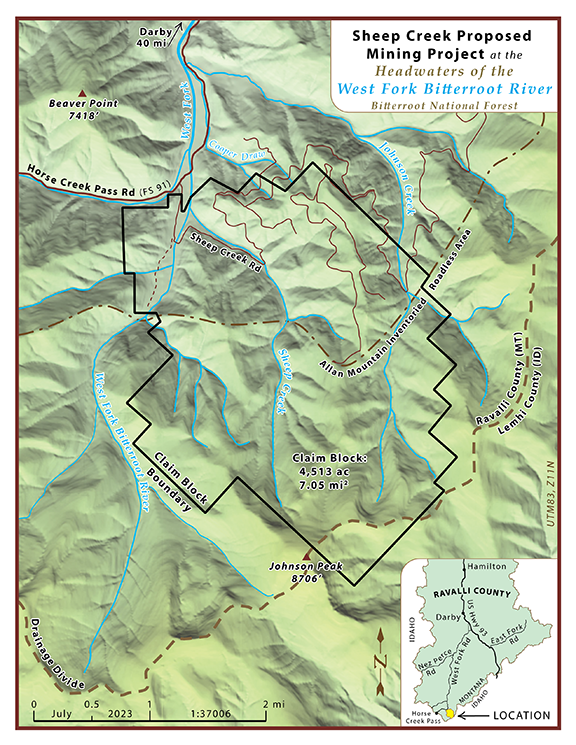
Actions
To be notified in a timely manner contact West Fork Ranger and ask to be included on the list of interested citizens: Daniel.pliley@usda.gov
Public comments are appropriate at any time, through letters to editors or on social media.
We just sent in these concerns as pre-scoping comments. You can use anything you want from these comments and express your own concerns to Daniel.pliley@usda.gov
Public comments to appropriate agencies can be submitted at any time. Opportunities include periodic official comment periods.
Visit our website for new information concerning rare earth mining and the Sheep Creek venture.
Proposed Bitterroot Sheep Creek Rare Earth Mine
by Larry Campbell for Friends of the Bitterroot
Recent corporate press releases announced that a deposit of rare earth elements in Sheep Creek, at the head of the West Fork of the Bitterroot River is being explored and promoted as a possible “green energy” mining opportunity. The deposit was discovered in the 1960’s and subjected to small scale mining. It remained dormant for about 50 years but has recently been revived by new owners, US Critical Materials, a shell company and US Critical Metals Corporation, based in Vancouver, Canada. US Critical Metals is a shell company of Resurgent Capital, based in Toronto, Canada. Resurgent Capital offers specialized services to mining executives in need of pre-planned “exit strategies” should they be found liable for activities related to their mines. The shell holds 223 mining claims covering more than 4,500 acres, or about 7 square miles, on the Bitterroot National Forest.
Rare earth elements, REEs, are a set of 17 nearly indistinguishable lustrous silvery-white soft heavy metals. Although similar in appearance they have very different properties and behaviors. They are not actually rare on earth, but they are rarely found concentrated in mineable deposits. Compounds containing rare earths have diverse industrial applications in electrical and electronic components, batteries, lasers, glass, magnetic materials, and industrial processes. Often found in combination with other members of the REE group they can be very difficult to separate.
New US government policies promoting rapid transition to “green energy” and electrical transportation along with tax subsidies have created a boom in exploration for and development of domestic REE and other “critical minerals”, especially since existing REE sources have been concentrated in China. In the rush to develop new domestic supply chains the US government has enabled expedited permitting procedures, both through Executive Orders and legislation. Additionally, government entities like the Defense Department, US Geological Survey and Montana Bureau of Mines and Geology are directly participating in the exploration boom.
The USGS announced regional airborne geophysics surveys for 2023 to explore both the Idaho cobalt belt as well as the REE-thorium belt, containing the Sheep Creek deposit. Various interested parties are hoping for economic synergy from multiple nearby mines and related manufacturing facilities.
REE’s ores are generally mined by excavating open pits and then leaching the ore in adjacent heaps or vats. Sometimes they are mined using in-situ leaching by injecting leaching agents into drill holes bored into the ore. The resulting chemical soup containing REEs is then captured for further processing. Leaching agents used to saturate the mined ore commonly include ammonium sulfate and ammonium chloride, both highly soluble in water and sometimes used as fertilizers. Materials used to refine and separate REEs from resulting concentrates include a witch’s brew of toxic chemicals.
Mining REE deposits requires blasting bedrock into rubble which makes removal possible and exponentially increases the surface area of rock, aiding chemical leaching. Unfortunately, it also exposes the increased rock surface area to ground water and air, leading to mobilization as dust or water drainage of metals and other constituents of the rock, like sulfides, asbestos, or radioactivity.
The companies claim the deposit contains the highest reported total rare-earth oxide grades of any rare earth deposit in the United States. REEs are often found associated with thorium, a radioactive element. U.S. Critical Materials says there's not enough thorium at Sheep Creek to require permitting from the U.S. Nuclear Regulatory Commission, supposedly giving the deposit a competitive advantage in addition to the reported high-grade assays. Their promotional material also declares that "Montana is a mining friendly state."
Late fall of 2022 the companies conducted non-mechanized exploration, opening a couple old adits (tunnels) and taking hand samples. They have submitted a Notice of Intent (NOI) to do similar work in 2023. Such hand work does not require NEPA public involvement. Although not included in the recent NOI, company press releases state they want to begin exploration drilling in 2023.
Potential environmental damage is not limited to mining, per se. Exploration activities before mining can also cause irreparable damage. Ground disturbing activities like drilling or road building would trigger the need for a BNF approved Plan of Operations, and accompanying NEPA public involvement process, as well as application for an Exploration License with the Montana Department of Environmental Quality. This would provide official public comment periods and opportunities to reality check just how “mining friendly” the Bitterroot actually is given the specific circumstances of the Sheep Creek situation.
“Green energy” sounds benign, but the development of needed materials can be quite environmentally damaging. In the case of a REE mine at Sheep Creek, location context is a critical element in the analysis. The mine would be at the very headwaters of the Bitterroot River, so water pollution could contaminate the length of the river clear to Missoula and beyond (like Butte on the Clark Fork).
There would be heavy metals, acid drainage, arsenic, radioactive thorium and possibly asbestos released from the bedrock. (The mineral actinolite is present in significant quantities. Actinolite can occur as asbestos.)
Water contamination by ammonium leaching agents could contribute to nutrient (Nitrogen and Phosphorous) pollution of the Bitterroot River, which supports threatened bull trout, westslope cutthroat trout as well as a very lucrative fishing industry. Nutrient pollution can lead to excessive algae growth and eutrophication.
Painted Rocks reservoir, a few miles below the mine site, provides reserved instream flow to the West Fork during late-season low flows. This supports irrigation and helps make the West Fork fishery a stronghold for survival by adding cold water from the reservoir to the late season warmed river water. Pollution of Painted Rocks by would be a big risk to existing locally owned, proven-sustainable, fishing industry as well as irrigated agriculture.
The Sheep Creek REE claim block spans a wildlife linkage corridor along the MT/ID divide connecting the Continental Divide corridor with the River Of No Return and Selway Bitterroot Wilderness right at a bottleneck in the Allan Mountain Inventoried Roadless area. The corridor is essentially Broadway for grizzly bears heading into the US Fish and Wildlife Service designated Bitterroot Grizzly Bear Recovery Area. Many other iconic species reside in or move through the Allan Mountain IRA, including wolverine, rocky mountain sheep, mountain goats, and Northern Rockies fisher.
The USFWS grizzly bear recovery plan depends on grizzly bears wandering into the Bitterroot Recovery Area. The connectivity corridor at stake is the only existing wildland corridor through the highly populated Bitterroot Valley.
Road building for drill rig access to the over 40 dikes containing REEs scattered across the claims would severely damage the connectivity corridor. At this crucial time for grizzly bear recovery wildlife displacement would begin immediately at a very strategic and vulnerable location and last for decades, even from “reclaimed” roads. Thus, even if the Sheep Creek mine does not pan out the way the corporate owners seem to want, there could be long-lasting damage to rare public values simply from exploration activities.
Exploration drilling could also contaminate ground water at the Bitterroot headwaters. Citizens should insist the BNF require the Company to characterize both the area ground water as well as Sheep Creek surface flow through monitoring prior to any drilling to develop a base line before any water contamination can occur from exploration road sediment, drilling materials, solvents, or fuel storage.
We expect the Company will soon submit an exploration Plan of Operation (PoO) to the BNF and MTDEQ. The permitting process could be quite abbreviated, so concerned citizens need to be prepared to act quickly.
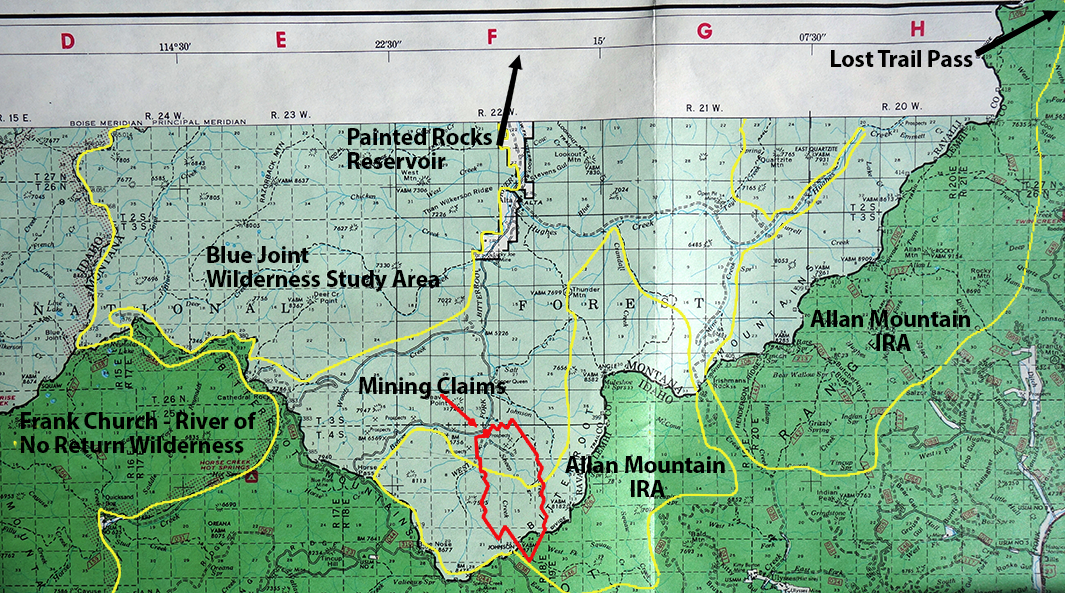
REE claim block at south end of the Bitterroot River
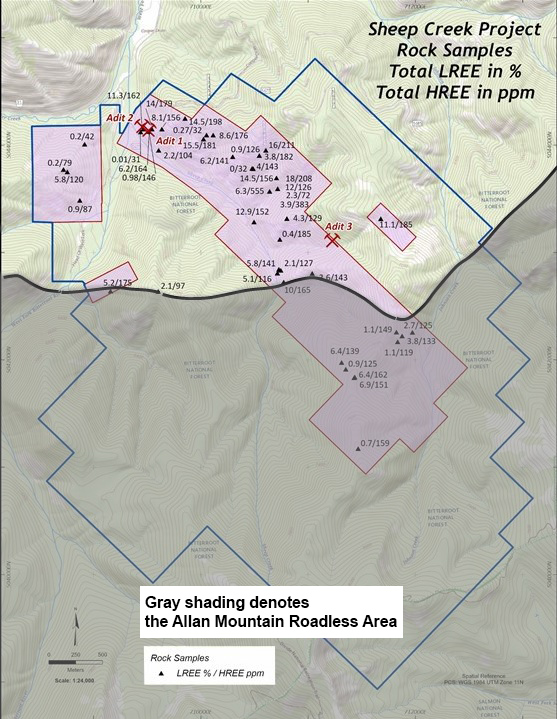
Note: Blue outlines the existing claim block. South of the black line is the Allan Mountain Inventoried Roadless Area
History
Rare earth minerals in the area were first discovered in the 1960s (Crowley, 1960; Heinrich and Levinson, 1961), but little work has been conducted since. In 2009, a company took 9 samples and submitted a Plan of Operation to the Forest Service. The company did not pursue the process and it was never subjected to NEPA and public comment. In the summer of 2022, US Critical Metals took 41 more samples and staked claims in the area. In the same year, Montana Tech conducted a study of the mineral deposits. This academic study will continue into the summer of 2023.
Next steps
The mining company has staked the claims. They have filed an NOI May 23, 2023 and it was accepted by the Forest Service. The next step will be a Plan of Operation outlining exploration drilling. The company plans to drill this summer. When submitted, the plan will be subject to the NEPA process and public comment through the Bitterroot National Forest.
The initial Plan of Operation will outline exploration drilling and plans in the area. Please note that exploration drilling can be very destructive. Unless they opt for helicopter drilling, it could include the construction of roads in the Allan Mountain Inventoried Roadless Area near the Frank Church River of No Return Wilderness.
What does rare earth mining look like?
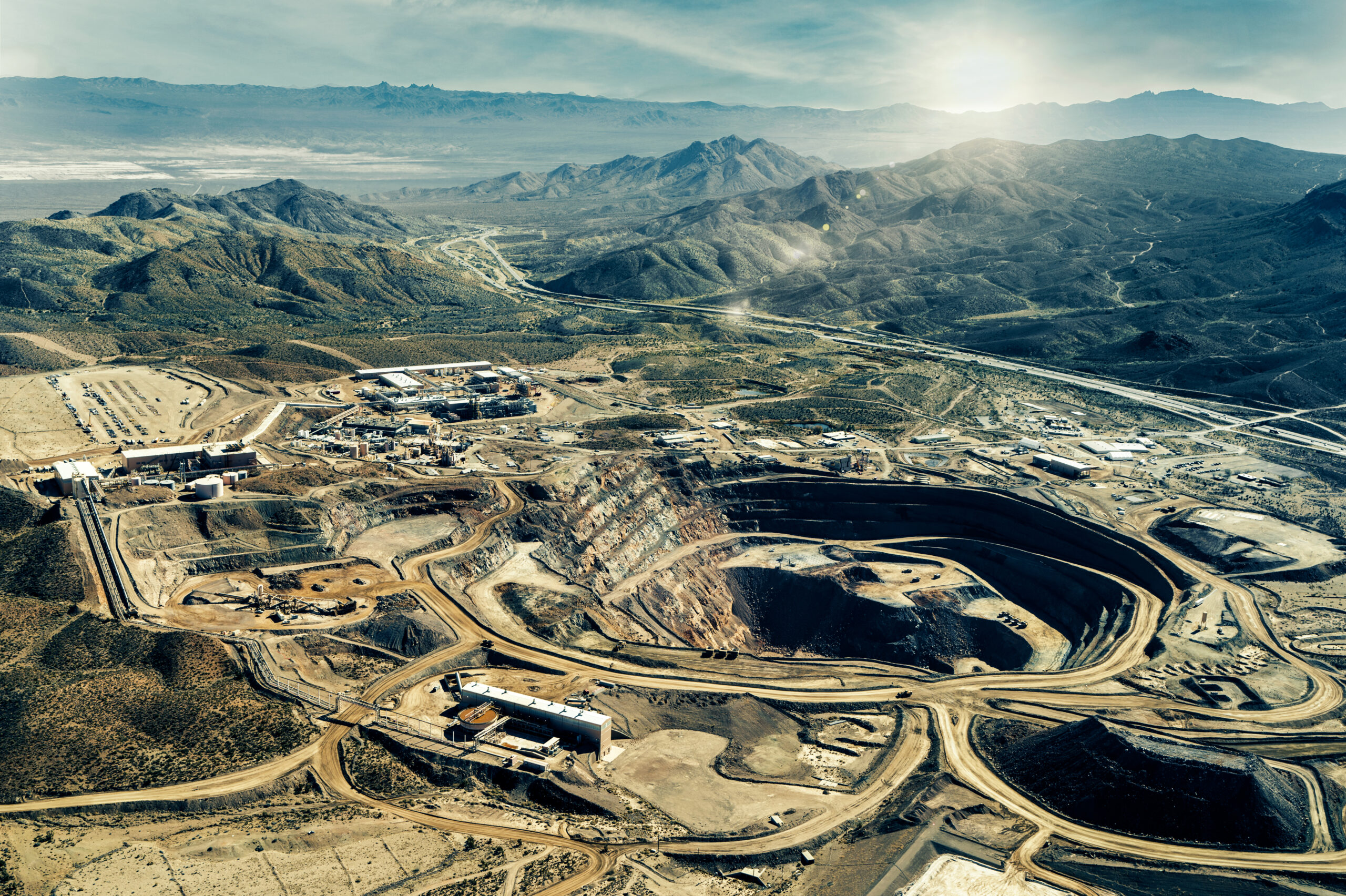
Mountain pass, California rare earth mineral ining and processing facility. Photo courtesy of Tmy 350 and Creative commons Attribution Share alike 4.0
News specific to Sheep Creek
No Plan of Operation yet for Sheep Creek mine, Bitterroot Star 5/7/2024
Mining Company out of Canada says it will continue to explore Bitterroot River Headwaters for Rare Earth Minerals Field and Stream, 5/8/2024
Sheep Creek drilling plan delayed, but mine sampling in the Bitterroot to continue in 2024, Daily Montanan, 5/2/2024
Sheep Creek Mine must be tested for asbestos before any ground disturbing exploration activity
Bitterroot Headwaters is a bad place for a mine. Missoula Current 8/10/2023
Potential mine near Sheep Creek worries Bitterroot valley residents. Montana Free Press 7/19/2023
Rare earth mining corporation is Canadian, leaders have court history Missoulian 6/3/2023
Companies look to increased mining of rare earth minerals Bitterroot Star, 3/22/23
Bitterroot Forest reacts to claims regarding West Fork mine Missoula Current, 3/17/23
Article on Sheep Creek in High Country News. High Country News, 3/162023
Bitterroot National Forest News Release 3/15/23
Proposed rare earth mine would sit along the headwaters of a legendary Montana Trout Stream MSN, Field and Stream, 3/13/23
US company claims USs richest rare earth deposit in Bitterroot The Missoulian, 3/8/23
Company aims to mine rare earth metals in the Bitterroot The Bitterroot Star, 3/8/23
Technical Information on Sheep Creek
Montana Tech Sheep Creek study information page
Articles on mining rare earth minerals
Why rare earth mining in the West is a bust High Country News, 6/16/15
How rare earth mining has devastated China's environment Earth.org, 7/14/20
Not so "green" technology: The complicated legacy of rare earth mining Harvard International Review, 8/12/21
Idaho is sitting on one of the most important elements on earth The Atlantic, 1/24/22
Deep-sea mining for rare metals will destroy ecosystems, say scientists The Guardian 3/26/23
The mining company website
https://www.uscmcorp.com/us-critical-metals-home
Maps, terms, regulations, etc
Mining Claims and Sites on Federal Lands Brochure 2021 Glossary of terms and rules
BNF Inventoried Roadless Area (IRA) map
Mining and Mineral Exploration
Sheep Creek Mine must be tested for asbestos before any ground disturbing exploration activity
Blank Plan of Operation Application
Anatomy of a mine from prospect to production
US Government expedited and subsidized mineral development
Fact-sheet: Securing a made in America supply chain for critical minerals 2/22/22
Water usage in rare earth mining
Water usage in industries of the future: Mining industry 7/2003
Ask a geologist: How much water usage is required to mine gold
Permitting and regulations
The need for mining law reform Department of Interior discussion on Reforming the mining law of 1872
FS Handbook re: Categorical Exclusions (CE) see p.12
Montana DEQ mineral exploration license
CEQ on protecting biological corridors, "“This guidance encourages Federal agencies to promote greater connectivity across terrestrial, marine, and freshwater habitats, as well as across airspaces, to sustain biodiversity and to enable wildlife to adapt to fluctuating environmental conditions, including those caused by climate change.”
Montana rock product permit flow chart
404 permit from Army Corps if they alter wetlands or impact WOTUS
NPDES permit for discharges from DEQ
Air quality permit for mining operations
Fixing America's Surface Transportation Act
3/8/23 CFR Regulations re: mining

